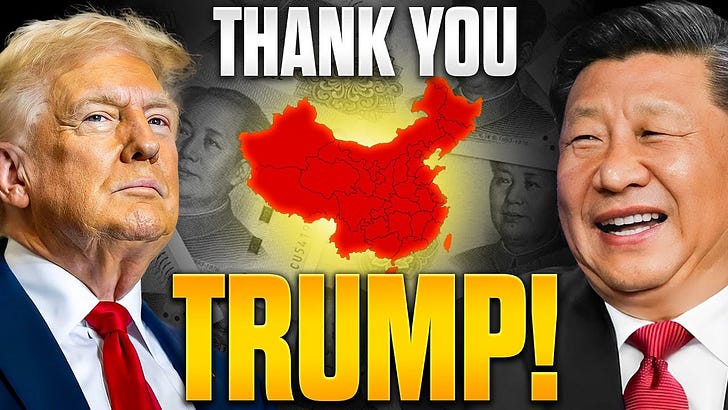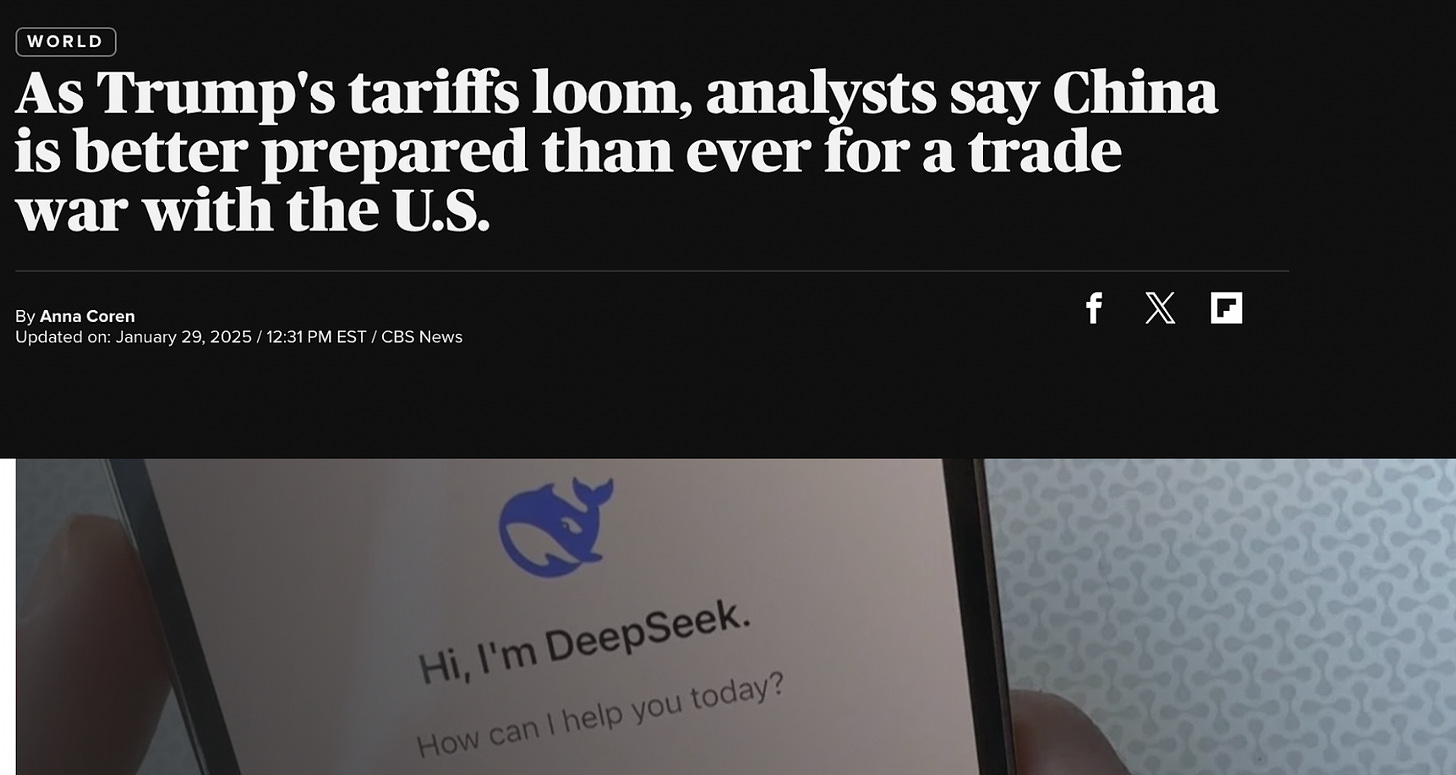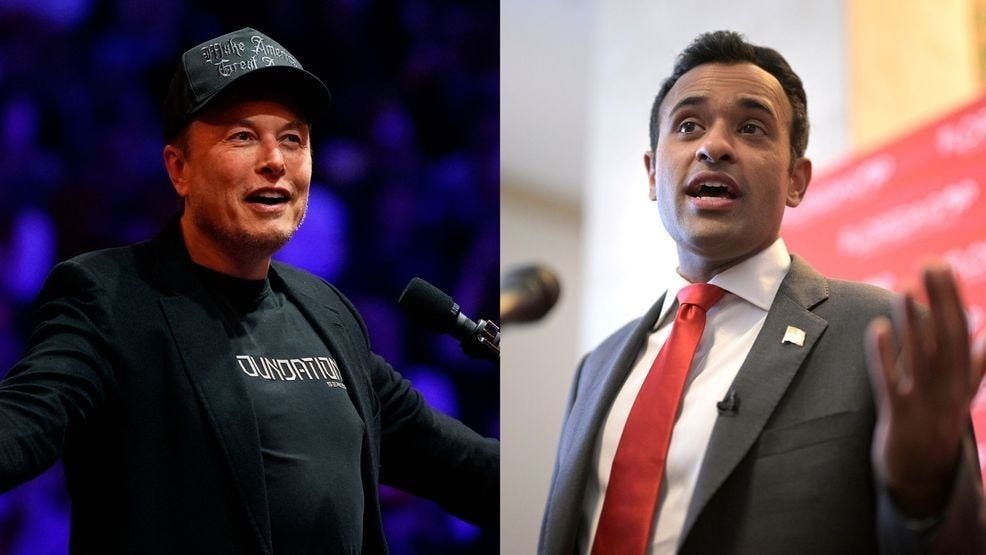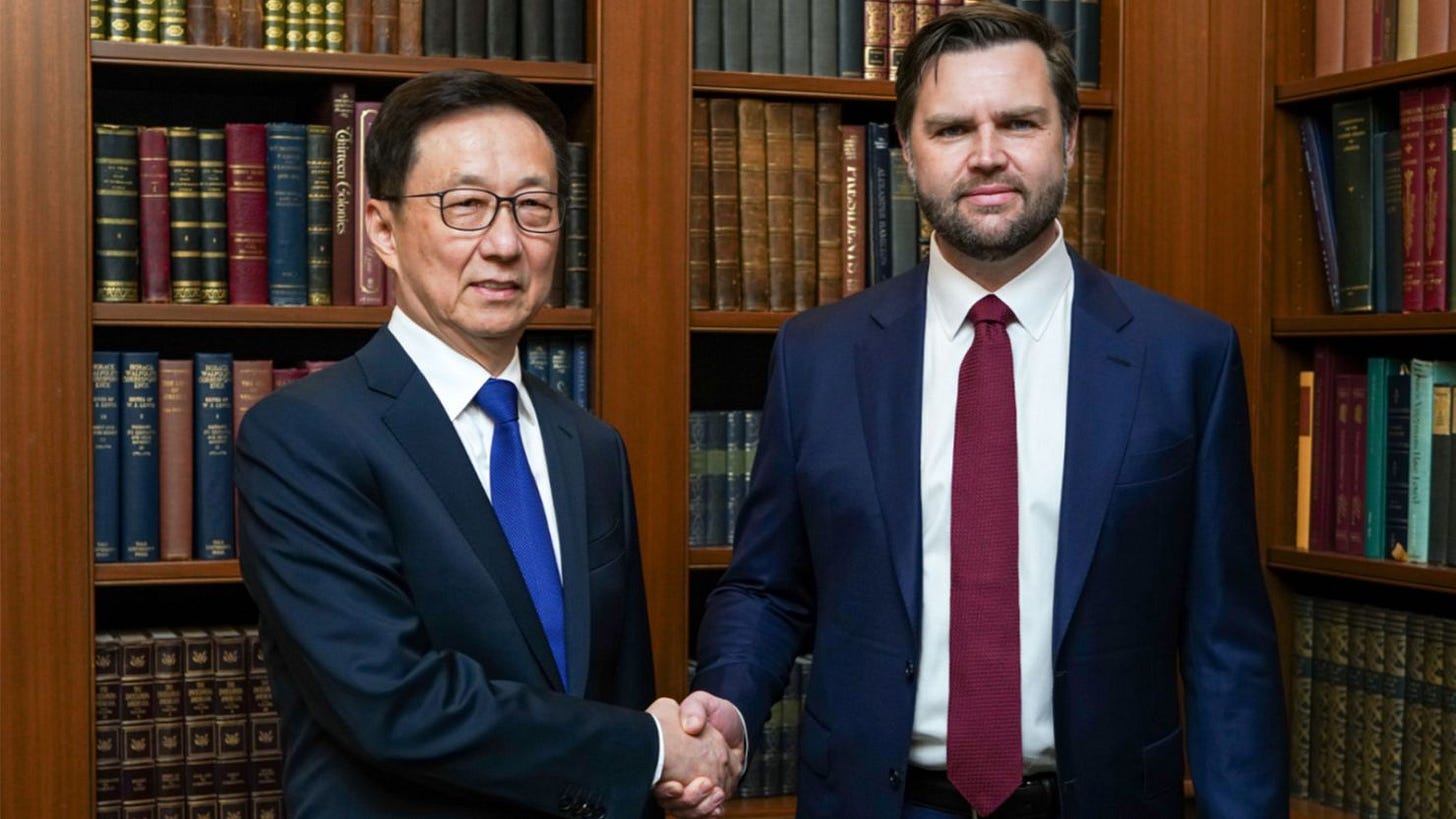In 2018, Donald Trump passed a series of sanctions and tariffs against China with one goal in mind: Stop China’s Rise. But what happened next is truly remarkable. China used each and every tariff as an opportunity to advance every industry Donald Trump targeted. When the US attacked China’s agriculture, the plan backfired to hurt US farmers more as China simply purchased soybeans from Brazil instead When Trump targeted China’s steel production, it resulted in China making a technological breakthrough that revolutionized the entire industry and when the US tried to stop Huawei, China’s largest and most successful tech company, Huawei not only survived, but responded with the fastest growth in 4 years.
And now, with China’s launch of DeepSeek-R1, the entire game has changed. This better-performing, open-source AI model has eliminated the last illusion that tariffs on China could ever work. Show me one industry where tariffs have achieved their intended goal of containing China. You can’t. And yet, crazily enough, we’re still seeing the same playbook. President Trump called tariffs quote “the most beautiful words in the dictionary” signaling we’re going straight back to his favorite tool from his first administration. But this time is different. China’s trade surplus with the world has reached nearly 1 trillion dollars, with $280 billion of that coming from the United States alone. This has put China in a position that many analysts believe makes it better prepared than ever for a trade war with the U.S.
But to prove exactly how tariffs have spurred Chinese innovation and made the country stronger, I want you to listen to this clip from David Sacks, a close Trump ally and leading voice in America’s AI industry:
Did you hear those last few words? Necessity’s been the mother of invention for them. And this is the primary reason that Trump’s tariffs and sanctions against China have never worked. Tariffs simply force China to work harder and smarter and accomplish more with less. For many years, China was the United States number one customer of semiconductors. In fact in 2023, China imported a total of $349 billion dollars worth of microchips, which was even higher than the $337 billion China spent on importing crude oil that year. But instead of allowing American companies like Intel to profit from robust trade with China, the US government destroyed this source of revenue, which resulted in Intel becoming the worst performing stock in the S&P 500 last year, as Intel's shares dropped 60% as the semiconductor pioneer struggled to adapt to a shifting landscape.
Meanwhile, Trump’s cabinet includes an unprecedented 13 billionaires, making it the wealthiest administration in history. Led by former hedge fund manager and now Treasury Secretary Scott Bessant this wealthy team believes they can cut taxes as much as possible and have tariffs make up the lost revenue. Just listen to these comments to see how far from reality Trump and his team are about tariffs:
It actually doesn’t make sense at all because that’s not how tariffs work. Tariffs are simply taxes. Taxing trade will mean less trade and higher prices for everyone, most especially American consumers. But Trump is willing to do whatever it takes to stop China’s growth, even if it means hurting the US economy. I guess that’s what happens when China launches the most advanced open source AI tool that rattled Wall Street and wiped away 1 trillion dollars from the stock market in a single day!

But there is a bigger story going on here as we now have legacy media companies like the Financial Times publishing articles Donald Trump and his team could have never imagined: “With DeepSeek, China innovates and the US imitates”
But now let me explain exactly how China rose so quickly and why most Americans failed to see this coming. Just read this amazing insight from that very Financial Times article which tells the truth about China:
The stereotypical image of China abroad may still be that of a state-subsidised, capital-intensive manufacturing economy that excels at churning out impressive low-cost hardware, such as smartphones, solar panels and electric vehicles. But, in truth, China long ago emerged as a global software superpower, outstripping the west in ecommerce and digital financial services, and it has invested massively in AI, too.
You see, the United States has an arrogance problem. Many tech executives think that only Silicon Valley can produce the world’s best technology and that sanctions and tariffs will actually stop China’s rise. To show you exactly what I mean, watch this unbelievable clip from Sam Altman, the CEO of OpenAI.
This clip is the most important part of today’s newsletter!
So watch it closely as Sam Altman is attending a tech event in India and is asked a simple question from an Indian entrepreneur about starting an AI company:
This clip from Sam Altman will go down in history as one of THE worst comments of all time in American tech. Because what Sam Altman said was impossible literally happened. Instead of India it was China and instead of $100 million dollars, China built DeepSeek AI with a budget of only $6 million dollars. But remember what David Sacks said earlier: necessity is the mother of invention. With DeepSeek being open-source and proving that top-tier models can be built with relatively small budgets, the playing field has been almost completely leveled. And if anyone has dominance in the space right now, it’s China. But once again, this story goes much much deeper.
Check out this tweet from Deedy, one of Silicon Valley’s top venture capitalists, who explains how the AI race is very much on:
What’s most interesting here is that the future of AI might not be the United States vs China. It could possibly be Beijing vs Shanghai vs Guangzhou, as so many Chinese companies are competing against each other domestically, quickly raising the bar of innovation in China. Just a few days after DeepSeek launched its R1 platform, Alibaba responded with their own AI tool called Qwen 2.5 that ranks even higher than DeepSeek’s model.
This is actually very common in China’s tech scene. Domestic competition spurs innovation. We’ve seen this first hand in China’s EV industry as hundreds of Chinese companies compete against each other domestically with only the best companies surviving. Once again this is another massive point the United States misses. Competition is what breeds innovation, not sanctions and tariffs.
Frankly it’s been hard to keep up with the amount of tech breakthroughs China has achieved in the first month of 2025 alone. The floodgates have truly opened.


The year started off with the mass migration of users from TikTok to the Chinese app Xiaohongshu in response to the US government’s ban. This resulted in a huge soft power victory for China, allowing millions of Americans to see the truth about China and realize the US government has been spreading anti-China propaganda for years. DeepSeek has fundamentally changed the AI landscape and exposed how massively inflated the stock market is. and in the past few weeks, China has unveiled two more game-changing pieces of technology.
In yet another field where the United States was thought to have a massive lead, Chinese scientists have hit a massive milestone in the race to create the world’s fusion reactor.

Think of this as a nuclear power plant, but instead of splitting atoms to create energy, these new reactors fuse atoms together—exactly the same way our sun creates energy. When this technology is fully realized, it will offer essentially unlimited clean energy. This past week, Chinese scientists took us one step closer to this future by generating a steady loop of plasma for a record-shattering 17 minutes.
But China wasn’t finished, one week later, a Chinese company in direct competition with Elon Musk’s Starlink revolutionized the low-orbit satellite industry. They’ve created a satellite that achieved a record data transmission rate of 100 GB per second using a laser. To put this into perspective, that’s equivalent to transmitting 10 full-length movies in just one second. This is 10x faster than Elon’s Starlink and puts China in a position to deliver lightning-fast 6G connectivity to even the most remote locations in the world.
As I often say, we need to study China because the Chinese are inventing the technologies that will shape the future of our world, but instead of celebrating these incredible accomplishments, Washington DC has been sent into full panic mode. Melanie Hart, the Senior Director of the Atlantic Council's Global China Hub is now advocating for the U.S. to “steal” China’s best AI talent to keep pace with China. It’s quite the bold statement to make but also shows how disconnected from reality some of our leaders in Washington DC are about China. The truth is the exact opposite is happening: Chinese scientists are leaving top US universities to take up high-profile roles in China, boosting Beijing in its race for global talent. This is a result of years of racial profiling and mistreatment from the US government towards Chinese scientists.
But when we start to do some research about the rise of China’s tech industry you’ll quickly discover that academic research and recruiting the best talent in the world is exactly how China is closing the technology gap with the United States.

While the opinion of American military think tanks and tech billionaires remains stuck in a hyper-competitive, antagonistic relationship with China, we’re seeing a surprising shift in policy from the Trump administration. Let’s not forget that during his campaign for presidency, Donald Trump promised American voters he would slap 60% tariffs on all goods from China. But those tariffs passed this week and were dropped to a much more reasonable 10%. Trump’s cabinet realizes how damaging 60% tariffs would be to the US economy and had to immediately pivot to a new strategy. In a move that no one could have predicted, Trump instead targeted Taiwan’s semiconductor industry with high tariffs in an attempt to get them to relocate to the United States.
He’s also questioned the aid the US government has giving to the island and snubbed the delegation that traveled all the way to Washington from attending his inauguration ceremony. This was a massive loss of face for the Taiwanese delegation but you know who was in attendance and was given top priority to attend?
China’s Vice President Han Zheng, pictured here with Vice President JD Vance just ahead of Trump’s inauguration. This has all culminated in one of the most shocking clips of the year—and potentially the biggest change in US-China policy in decades. Trump’s Secretary of State, Marco Rubio, who has been notoriously one of the largest China hawks in Washington, finally admitted that the unipolar world, where the United States is the only dominant force is officially over.
The Trump administration—after spending years ramping up tensions—is now the first in decades to publicly acknowledge multipolarity. With Marco Rubio’s stunning comments, we are seeing a shift away from the reckless neoconservative strategy that has defined U.S. foreign policy for the past twenty years. Washington’s leading China hawks, the very people who pushed for economic and military containment, are now being forced to admit reality: China’s dominance is undeniable, and competing through hostility is no longer an option.
Does this mark a genuine change in American policy, or is it just political theater? With Trump, it’s impossible to say. His cabinet is packed with billionaires and protectionist hardliners who still want to weaponize tariffs, yet he has also walked back the most extreme measures and appears open to negotiation. The real question is whether this pivot towards pragmatism is a long-term strategy or just another short-term maneuver.
Regardless of what happens next, one thing is clear: America’s attempts to contain China have completely backfired, and the rest of the world has taken notice. From AI to energy to global trade, China is shaping the future while Washington is still trying to rewrite the past. And this is only the beginning. As these developments continue to unfold, the geopolitical landscape is shifting before our eyes.










That is not what built their tech industry.
It has been built over decades when Western corporations decided to offshore their manufacturing capabilities to China for low wages and little regulation.
In return the Chinese required access to IP and manufacturing capabilities that allowed them to catch up to the West.
They also took advantage by sending their students overseas and others to learn (& steal) additional critical information!
The tariffs are just the icing on the cake.
I copied the following insight from the article, Trump has a lot to learn from Cyrus.
Tariffs simply force China to work harder and smarter and accomplish more with less.